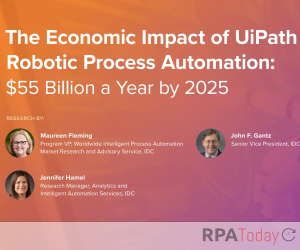
A recent analysis of UiPath customers found that the economic impact of implementing RPA in an organization will grow from $7 billion annually this year to $55 billion annually in 2025. While this measure looked at UiPath, specifically, there are general conclusions drawn by analysts at IDC, who conducted the study.
Of the economic benefit that accrued to organizations from RPA, 44 percent of them cited lower expenses as the biggest driver of that benefit. The report said that, while lower expenses could mean reductions in human labor costs associated with a smaller workforce, reduced headcount was not as significant as other areas of savings. Other savings were manifested in faster inventory turns, more efficient purchasing, and less downtime.
Forty-one percent identified revenue improvement as the biggest factor in the economic impact of RPA to their business. The report said that improvement was “generally tied to faster processing times and higher-quality customer experiences that result in higher renewal rates, faster customer acquisition or higher booking values.”
IDC’s model showed that 12 million workers worldwide interfaced with RPA in some way in 2020 and the report estimates that will climb to 35 million by the end of 2025. It also found that, despite labor costs being a driver of economic impact, IDC estimates that two jobs are created for each one lost to RPA.
“Only 7 percent of digitally enabled task workers have been impacted by the use of RPA,” said report co-author Maureen Fleming, program vice president of intelligent process automation research at IDC. “At this study’s projected rate of adoption, task workers impacted will grow at a compound annual growth rate of 70 percent from 2020-2025, accounting for 10 percent of task workers impacted. RPA is not even to the ‘knee of the curve’ of adoption. Results of the study show that RPA is touching millions of dollars of global business revenue, creating thousands of jobs, and opening billions of dollars in opportunities to ecosystem partners.”

